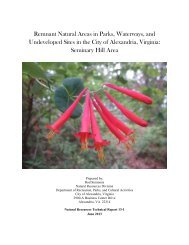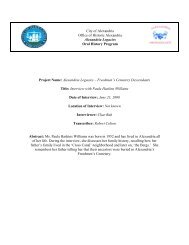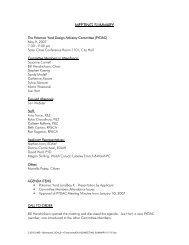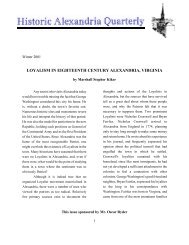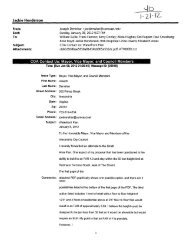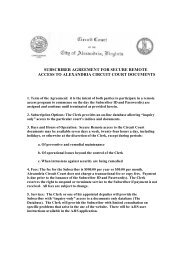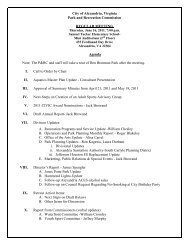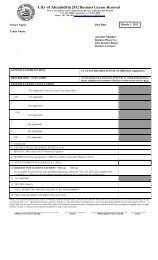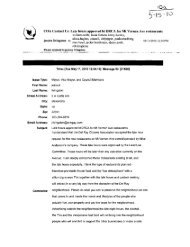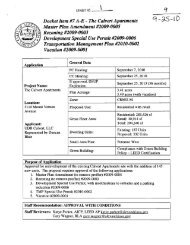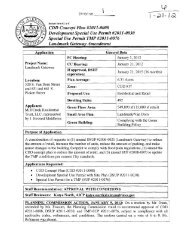Potomac Waterfront Flood Mitigation Study - City of Alexandria
Potomac Waterfront Flood Mitigation Study - City of Alexandria
Potomac Waterfront Flood Mitigation Study - City of Alexandria
You also want an ePaper? Increase the reach of your titles
YUMPU automatically turns print PDFs into web optimized ePapers that Google loves.
Overview <strong>of</strong> <strong>Flood</strong> <strong>Mitigation</strong> Measures<br />
SECTION THREE: OVERVIEW OF FLOOD MITIGATION MEASURES<br />
As described in Section 2, ten flood mitigation techniques were selected for further<br />
consideration. They include measures that have structural elements, such as flood barriers, as<br />
well as those that do not require structural changes, such as ordinance revisions and modification<br />
to the <strong>City</strong>’s sandbag program. It should be noted that the ranking analyses were performed<br />
without assessing specific applicability to the <strong>City</strong>. The flood mitigation measures and their<br />
applicability for use within the <strong>City</strong> <strong>of</strong> <strong>Alexandria</strong> are described in this section.<br />
3.1 STRUCTURAL MITIGATION MEASURES<br />
3.1.1 Structural <strong>Flood</strong> Barriers<br />
<strong>Flood</strong> barriers are man-made structures that are built to protect low-lying areas from the<br />
inundation <strong>of</strong> floodwaters. These barriers provide either permanent or temporary flood<br />
protection. Temporary flood barriers are described in Section 3.2.3.<br />
Permanent flood protection is a passive system, meaning it is always in place and requires no<br />
human interaction to activate during flood events. These measures include levees, floodwalls,<br />
and berms. Levees and berms are typically earthen structures that require significant land while<br />
floodwalls take up less space and are typically constructed <strong>of</strong> concrete or steel. Permanent flood<br />
protection is typically an expensive option, which requires ongoing maintenance for continued<br />
flood protection.<br />
Selection <strong>of</strong> the most appropriate flood barrier needs to take into account the frequency, typical<br />
depth, and duration <strong>of</strong> flooding. Next, the level <strong>of</strong> protection desired and the size <strong>of</strong> the area that<br />
needs protection need to be considered. Since the areas being protected by the systems are lowlying,<br />
all flood protection methods need to be extended to (i.e., tied-in to) high ground.<br />
Aesthetics is another important consideration in choosing an appropriate flood barrier. Levees,<br />
floodwalls and berms cause visual impacts and can be viewed as unattractive; they may also<br />
hinder access to waterways. Access to waterways through a flood barrier can be provided by<br />
using a floodgate, which is an opening in the flood barrier that is lowered or closed during flood<br />
events. Consideration <strong>of</strong> all <strong>of</strong> these factors will determine the best type <strong>of</strong> flood barrier for the<br />
project area.<br />
Once the flood barrier is selected, an important design component is interior drainage. During<br />
most rainfall storm events, the discharge from the interior areas can be conveyed by gravity<br />
through the existing stormdrain systems. Stormdrain systems are typically designed to convey<br />
the 10-year discharge.<br />
However, during periods <strong>of</strong> high elevation on the <strong>Potomac</strong> River, high water in the river prevents<br />
gravity flow through the stormdrain system, while flapgates prevent back flow. During this<br />
worst-case scenario (referred to as “coincident peaks”), the flood barrier system would need to<br />
convey the interior drainage for events at least up to the estimated 100-year flood discharge.<br />
Therefore, design concepts include pumping stations to pump the discharge into the <strong>Potomac</strong><br />
River in the event the flapgates are sealed or blocked.<br />
Finally, if the flood protection barrier is to be recognized by FEMA as a flood protection device,<br />
the levee must meet the requirements contained in Section 65.10 <strong>of</strong> the National <strong>Flood</strong> Insurance<br />
28-JUL-10\\ 3-1



